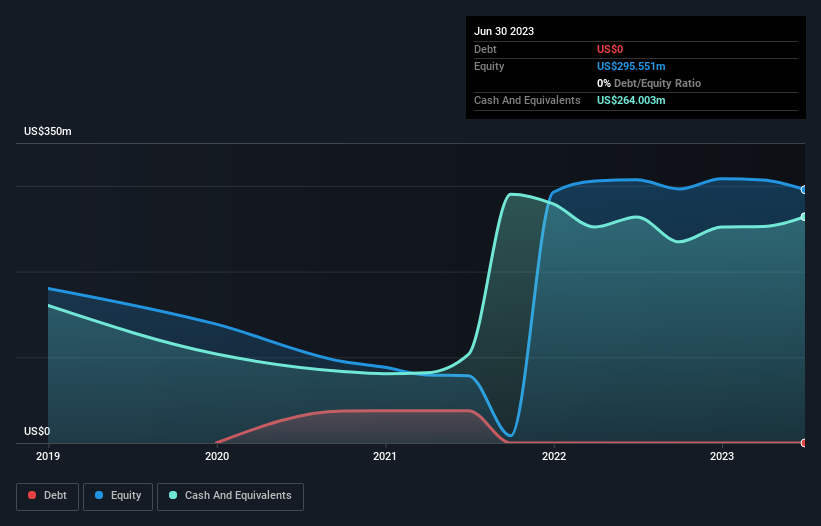- United States
- /
- Consumer Services
- /
- NasdaqGM:ROVR
We're Not Worried About Rover Group's (NASDAQ:ROVR) Cash Burn
We can readily understand why investors are attracted to unprofitable companies. For example, biotech and mining exploration companies often lose money for years before finding success with a new treatment or mineral discovery. Nonetheless, only a fool would ignore the risk that a loss making company burns through its cash too quickly.
So, the natural question for Rover Group (NASDAQ:ROVR) shareholders is whether they should be concerned by its rate of cash burn. In this report, we will consider the company's annual negative free cash flow, henceforth referring to it as the 'cash burn'. We'll start by comparing its cash burn with its cash reserves in order to calculate its cash runway.
Check out our latest analysis for Rover Group
When Might Rover Group Run Out Of Money?
A company's cash runway is the amount of time it would take to burn through its cash reserves at its current cash burn rate. When Rover Group last reported its balance sheet in June 2023, it had zero debt and cash worth US$264m. Importantly, its cash burn was US$1.2m over the trailing twelve months. That means it had a cash runway of very many years as of June 2023. The image below shows how its cash balance has been changing over the last few years.

How Well Is Rover Group Growing?
Rover Group managed to reduce its cash burn by 79% over the last twelve months, which suggests it's on the right flight path. And revenue is up 40% in that same period; also a good sign. Overall, we'd say its growth is rather impressive. Clearly, however, the crucial factor is whether the company will grow its business going forward. For that reason, it makes a lot of sense to take a look at our analyst forecasts for the company.
How Hard Would It Be For Rover Group To Raise More Cash For Growth?
There's no doubt Rover Group seems to be in a fairly good position, when it comes to managing its cash burn, but even if it's only hypothetical, it's always worth asking how easily it could raise more money to fund growth. Issuing new shares, or taking on debt, are the most common ways for a listed company to raise more money for its business. Commonly, a business will sell new shares in itself to raise cash and drive growth. By looking at a company's cash burn relative to its market capitalisation, we gain insight on how much shareholders would be diluted if the company needed to raise enough cash to cover another year's cash burn.
Rover Group has a market capitalisation of US$1.2b and burnt through US$1.2m last year, which is 0.1% of the company's market value. That means it could easily issue a few shares to fund more growth, and might well be in a position to borrow cheaply.
So, Should We Worry About Rover Group's Cash Burn?
It may already be apparent to you that we're relatively comfortable with the way Rover Group is burning through its cash. For example, we think its cash runway suggests that the company is on a good path. But it's fair to say that its revenue growth was also very reassuring. After considering a range of factors in this article, we're pretty relaxed about its cash burn, since the company seems to be in a good position to continue to fund its growth. When you don't have traditional metrics like earnings per share and free cash flow to value a company, many are extra motivated to consider qualitative factors such as whether insiders are buying or selling shares. Please Note: Rover Group insiders have been trading shares, according to our data. Click here to check whether insiders have been buying or selling.
Of course Rover Group may not be the best stock to buy. So you may wish to see this free collection of companies boasting high return on equity, or this list of stocks that insiders are buying.
New: AI Stock Screener & Alerts
Our new AI Stock Screener scans the market every day to uncover opportunities.
• Dividend Powerhouses (3%+ Yield)
• Undervalued Small Caps with Insider Buying
• High growth Tech and AI Companies
Or build your own from over 50 metrics.
Have feedback on this article? Concerned about the content? Get in touch with us directly. Alternatively, email editorial-team (at) simplywallst.com.
This article by Simply Wall St is general in nature. We provide commentary based on historical data and analyst forecasts only using an unbiased methodology and our articles are not intended to be financial advice. It does not constitute a recommendation to buy or sell any stock, and does not take account of your objectives, or your financial situation. We aim to bring you long-term focused analysis driven by fundamental data. Note that our analysis may not factor in the latest price-sensitive company announcements or qualitative material. Simply Wall St has no position in any stocks mentioned.
About NasdaqGM:ROVR
Rover Group
Rover Group, Inc. operates an online marketplace for pet care worldwide.
Flawless balance sheet with high growth potential.
Similar Companies
Market Insights
Community Narratives




